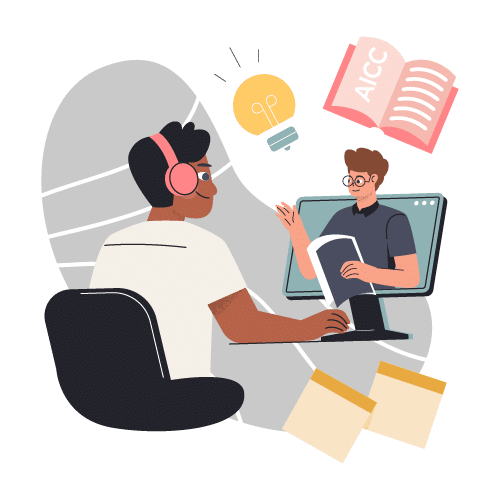Nowadays, it’s common to have an express version of software applications or fast-track processes. But what about rapid eLearning development? Is it possible to build eLearning solutions quickly and effectively?
Let’s find out about the benefits, process, and tools that rapid eLearning development involves.
What Is Rapid eLearning Development?
A rapid eLearning development process allows the creation of eLearning solutions in weeks instead of months without compromising quality. It requires a smaller team of people and technology that’s easy to use even by team members and subject matter experts who may not be technologically savvy. The rapid eLearning development doesn’t neglect any part of traditional eLearning development— putting a spotlight on learning activities and assessments. However, rapid elearning development sets itself apart by following a different process. How? Check out some of the processes that are different::
- Reuse. Templates save months of work:
- Rapid eLearning project managers use templates for eLearning project planning.
- Rapid learning experience designers (LXDs) use templates to create eLearning storyboards quickly. These templates work as blueprints for the development of eLearning solutions.
- Finally, visual designers and programmers use templates to design and implement visual and interactive elements.
- Resource allocation. Rapid eLearning development allocates human resources in ways that reduce the project’s duration and turnaround time. For instance, a SME and an LXD can work together to create a rapid eLearning solution. They can plan the project, create a storyboard, and implement the solution with a rapid authoring tool in no time!
- Repurpose. To the extent possible, rapid eLearning development repurposes content that already exists. It reuses images, audio clips, videos, interviews, quizzes, and many more content pieces! So, instead of reinventing the wheel, you take the shortcut and use what you already have, ensuring you meet tight deadlines.
- Iterations. One of the hard parts of any project is producing the first draft. But rapid eLearning development is agile and iterative. Therefore, you can’t don’t over every detail and choose progress over perfection. That’s why rapid eLearning development goes hand in hand with the SAM model. In other words, get to the first version as soon as you can, and embellish it afterward.
- Less programming. With authoring tools, you can skip a lot of the programming effort involved in building eLearning solutions from scratch. That saves you not only time but also resources—the programmers. And all you have to do instead is drag, drop, and configure assets from libraries and templates. Oh! You’ll also love publishing your eLearning solutions according to standards such as SCORM, Tin Can API, or AICC.
As a result of following a rapid process, you speed up eLearning development. This means it gets quicker and easier to:
- Create the storyboard
- Include written and multimedia content
- Make the eLearning solution interactive
Curious about why your business needs to save time and money on eLearning development?
The Perks of Rapid eLearning Development
The overall fast-paced business environment we live in calls for a generalized sense of urgency. Time to market is essential and is why you need eLearning solutions ready yesterday. Imagine the consequences if your customer support team didn’t get product training in time for a product launch.
On top of the time to market, you should maintain a knowledgeable, skilled, and compliant workforce at all times. And that would be difficult without timely and frequent delivery of training on multiple topics. Traditional eLearning development may not work for that volume and frequency of training.
A rapid process of developing eLearning solutions allows updating content on an ongoing basis. Why? Because rapid eLearning solutions are highly modular and the process is iterative. Consequently, you can change the content or improve the solution’s interactivity quickly and easily.
In addition, you get your eLearning ROI fast (because you deliver fast). Rapid eLearning development reduces the development time, thus enabling quick rollouts. In turn, the learning outcomes come to life much sooner than they do with a traditional approach.
Next, you’ll find our best pieces of advice on rapid eLearning development (from our experience).
7 Tips to Create a Rapid eLearning Development Process
Before kicking off a rapid eLearning development project, consider the tips below and adapt to your context. We’re assuming that you already evaluated the project’s suitability to a rapid process. We’re also assuming that you checked the availability of the reusable content.
1. Choose the authoring tool wisely.
Does the SME know the tool? Have they worked with it before? If not, you should reconsider using that particular authoring tool.
2. Get a head start.
Identify the right asset libraries and templates. Make sure that they’re appropriate for your client, not only in terms of look and feel but also effectiveness.
3. Guide your SMEs through the process.
Create a style guide for your SMEs and make sure they get familiar with it before you start. Do you think that they might get something wrong—be sure they’re clear on all aspects of the guide? Don’t take any chances that might cost the project time! Keep the style guide up to date at all times, and if you update it, notify your SMEs.
4. Embrace work in progress.
If the content isn’t ready at the start of the training, make that clear right from the start. Communicate your plan to your learners. That way, they’ll know to expect additional content over the time of training.
5. Fill in the gaps in content rapidly.
If the existing content isn’t complete for your learners to achieve the expected learning outcomes, fix that quickly. For instance, the SME can quickly record an audio clip or a video to fill in the gaps.
6. Organize learning in modules.
This will come in handy to develop your eLearning solution iteratively. Think of a module as a standalone, small block of training content that teaches one subtopic of your training’s overall topic.
Although a module can relate to other modules, organize them sequentially. And if you don’t have some ready as learners begin the initial modules, no problem, because you only grant access to sequential modules once the learner completes the previous ones.
7. Implement an online review process.
Modern authoring tools enable online reviews with tools such as zipBoard. No more missed emails with important feedback or merges of contradictory reviews. Collaboration is the key to a simple review process!
To get the feedback of SMEs or other stakeholders, share the link to your online course with them. They won’t have to download any software before starting to review the course. And they’ll be able to see others’ comments and suggestions, and you’ll be able to reply to them.
If you’re thinking about the tools you need to put all this into practice, your answer is just below.
Best Rapid eLearning Development Tools
Instead of suggesting specific rapid authoring tools—such as Articulate 360 or Adobe Captivate—we prefer to guide you. Therefore, we’ll give you our formula to choose the rapid authoring tool that best suits your needs.
Authoring tools used to be complex and required special training. Also, integrating them with learning management systems could be difficult.
Both those factors made the entire process lack efficiency.. Only trained instructional designers were able to use those old versions of authoring tools.
But nowadays, anyone can use rapid authoring tools after a brief introduction. And that doesn’t mean that interactive modules, multimedia content, or mobile compatibility is out the window—on the contrary.
Whatever rapid authoring tool you choose, make sure that they have:
- The libraries and templates for your eLearning solutions to look good and be easy to navigate
- Powerful drag-and-drop features to replace the hard programming of interactive modules for learning activities, assessments, and communication (synchronous and asynchronous)
What Now?
Whether you need to train your own employees, partners, or customers, timing is everything! The right tools and a rapid eLearning development process may be just what you need to move quickly.
But if you feel hesitant, rapid eLearning development is most appropriate when:
- The training content changes quickly. That’s frequently the case with sales training, product training, and compliance training.
- The training itself rapidly depreciates. For instance, training staff for a major event that only happens once every five years fits into this category.
- You need to deliver the training urgently. A law that requires you to implement changes at your company in a few weeks calls for a rapid process.
Your first rapid eLearning development project will lay the foundation for others to come, and you’ll constantly improve. So, your project plan, storyboard, and design templates will only get better as time moves on!
Get in touch for more information on how we can help you leverage your rapid eLearning development projects!






